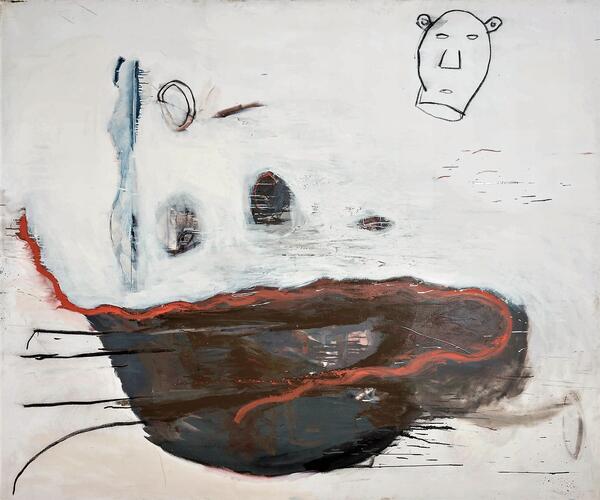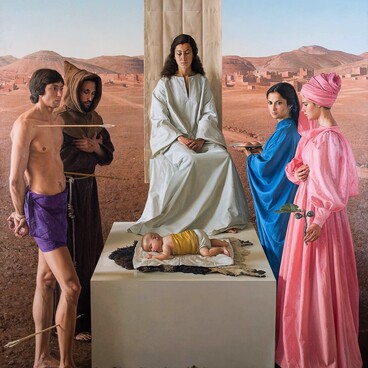“Andromache I” was created by a French painter Hélène Delprat. The abstract composition features figurative components that are not connected in any way. This leaves the work and its elements open to interpretation.
The name of the painting alludes to Greek mythology. Andromache was the wife of Hector who died in the Trojan War. Her character is often used to represent fidelity and love triumphing over death. When Troy fell and her husband was killed, she mourned and lamented over her loss.
“Andromache I” follows the tradition of French exoticism, driven by an interest in the unusual and mysterious culture of other regions. This trend set the direction for French art in the early 20th century, when numerous artists, including the Cubists, were drawn to African or Oceanic cultures and appropriated some of their traditional elements for their works.
Hélène Delprat takes an interest in the art of primitive and traditional societies, especially African culture with its religion and rituals. The artist often peruses scientific articles and fiction books describing ancient cultures, as well as frequents ethnological museums in search of new subjects for her paintings.
Hélène Delprat’s famous works depict dark dreams that unfold in caves and tombs. The canvases depict mysterious signs: the artist uses them to reflect the sense of fear of impending death, including her own as well.
Hélène Delprat was born in the French city of Amiens in 1957. She studied at the National School of Fine Arts in Paris, as well as in the French Academy in Rome in the 1980s. In 2014, she returned to the National School of Fine Arts in Paris as a professor.
Delprat’s art is considered innovative: her works are inspired by history and literature, painting and drawing, cinematography and social media.
Nowadays, the artist lives and works in Paris. She is engaged in painting, as well as videography and stage design. Hélène Delprat’s works are housed by museums in France, Hungary, the Netherlands, Canada, the USA, and Russia.
The name of the painting alludes to Greek mythology. Andromache was the wife of Hector who died in the Trojan War. Her character is often used to represent fidelity and love triumphing over death. When Troy fell and her husband was killed, she mourned and lamented over her loss.
“Andromache I” follows the tradition of French exoticism, driven by an interest in the unusual and mysterious culture of other regions. This trend set the direction for French art in the early 20th century, when numerous artists, including the Cubists, were drawn to African or Oceanic cultures and appropriated some of their traditional elements for their works.
Hélène Delprat takes an interest in the art of primitive and traditional societies, especially African culture with its religion and rituals. The artist often peruses scientific articles and fiction books describing ancient cultures, as well as frequents ethnological museums in search of new subjects for her paintings.
Hélène Delprat’s famous works depict dark dreams that unfold in caves and tombs. The canvases depict mysterious signs: the artist uses them to reflect the sense of fear of impending death, including her own as well.
Hélène Delprat was born in the French city of Amiens in 1957. She studied at the National School of Fine Arts in Paris, as well as in the French Academy in Rome in the 1980s. In 2014, she returned to the National School of Fine Arts in Paris as a professor.
Delprat’s art is considered innovative: her works are inspired by history and literature, painting and drawing, cinematography and social media.
Nowadays, the artist lives and works in Paris. She is engaged in painting, as well as videography and stage design. Hélène Delprat’s works are housed by museums in France, Hungary, the Netherlands, Canada, the USA, and Russia.



